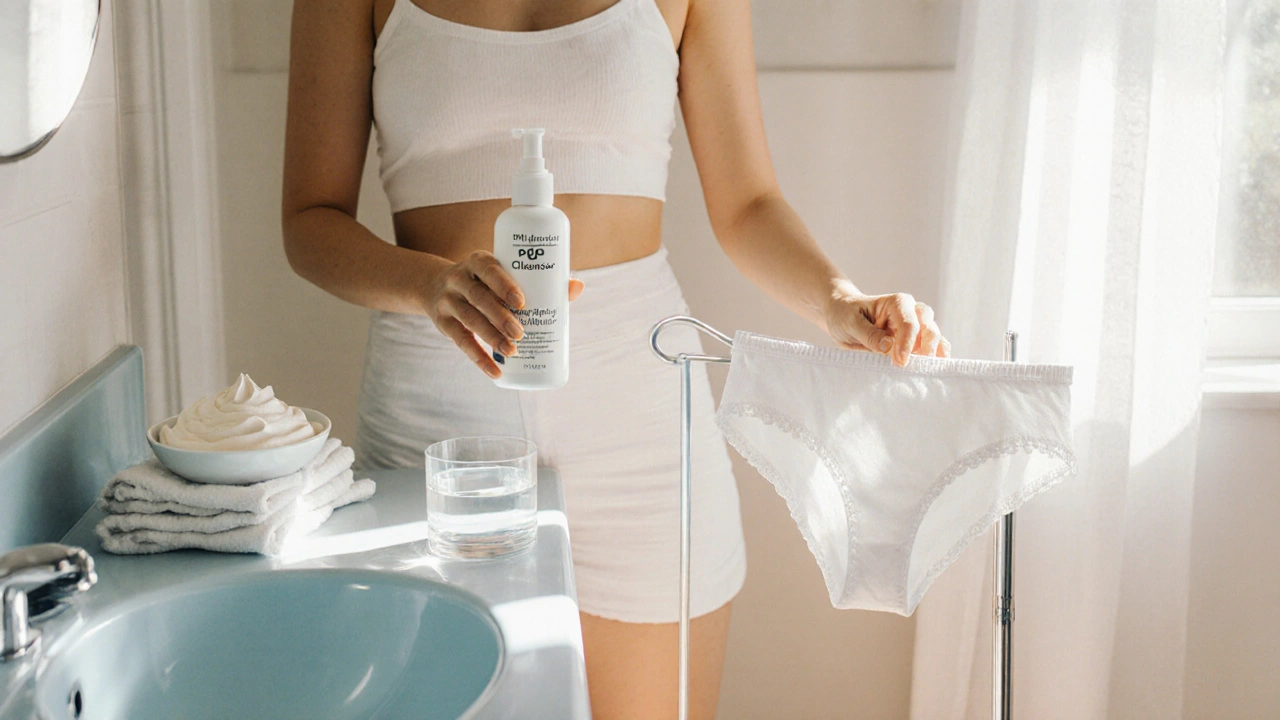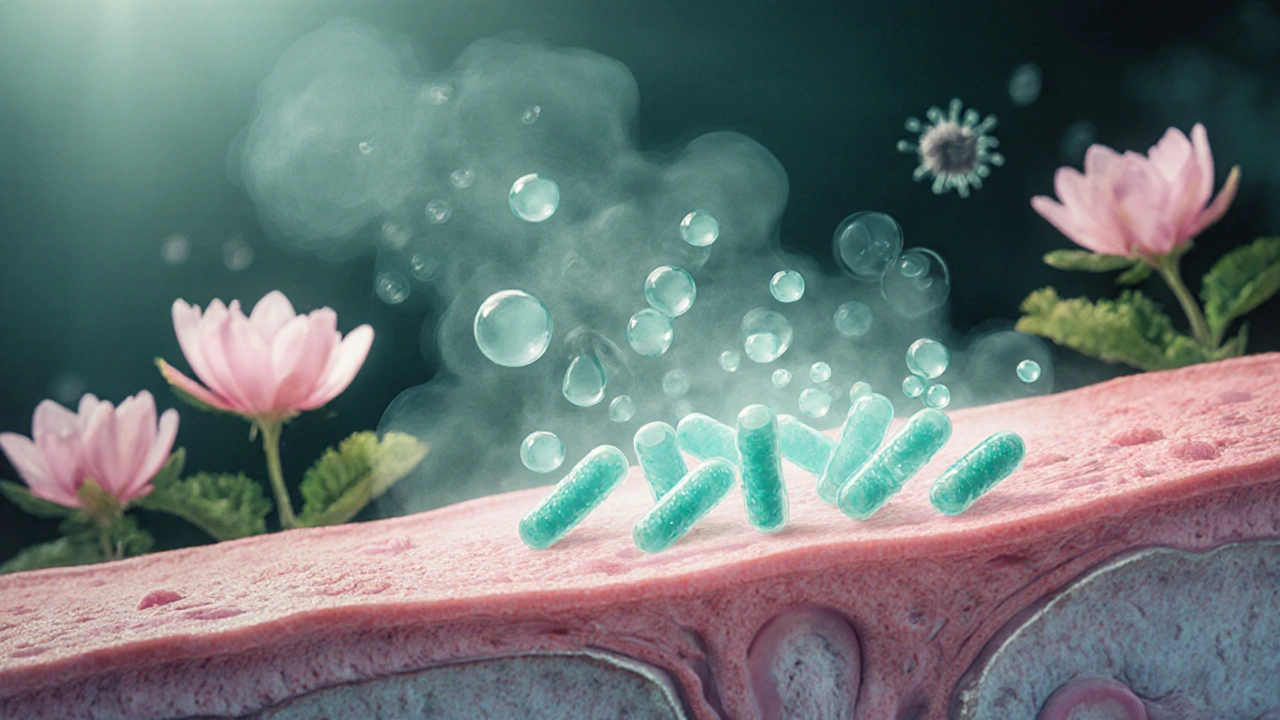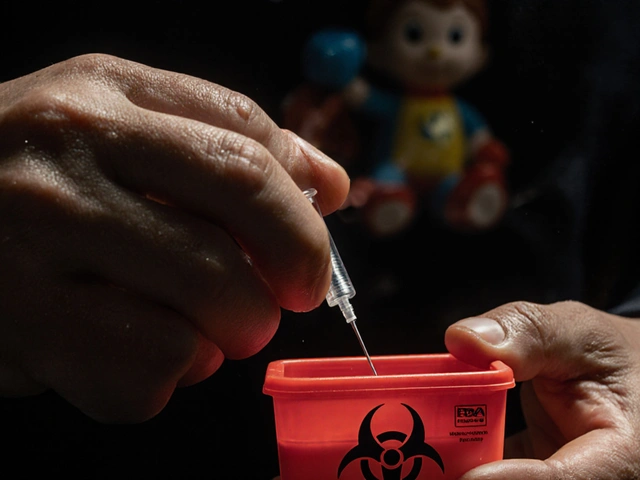Vaginal pH Balance Checker
Check Your Vaginal pH Level
Enter your pH reading below to see if it's within the healthy range (3.8-4.5).
Enter your pH value above to check your vaginal health status.
Why pH Matters
Maintaining a healthy vaginal pH (3.8-4.5) supports beneficial bacteria like Lactobacillus, which produce lactic acid to prevent harmful microbes from overgrowing.
Tips to Maintain Healthy pH
- Use gentle, pH-balanced cleansers
- Wear breathable cotton underwear
- Avoid douching and harsh soaps
- Consider probiotics with Lactobacillus strains
- Stay hydrated
Ever wonder why a simple change in a tiny number can mean the difference between comfort and irritation down there? The secret lies in vaginal pH balance. When that delicate acidity stays in the sweet spot, it keeps unwanted microbes at bay and lets you feel fresh. Slip out of that range, and you’re flirting with itching, burning, and a whole host of common problems. Below is a quick cheat‑sheet, followed by a step‑by‑step guide to keeping things in check.
TL;DR
- Normal vaginal pH is 3.8‑4.5; staying there prevents irritation.
- Lactobacillus bacteria create lactic acid, the main guardian of acidity.
- Disruptions from antibiotics, douches, or hormonal shifts raise pH and invite yeast or bacterial vaginosis.
- Simple habits - gentle cleansers, cotton underwear, pH‑testing strips - keep the environment stable.
- If irritation shows up, re‑establish balance before reaching for over‑the‑counter creams.
What Exactly Is Vaginal pH Balance?
Vaginal pH is a measure of acidity that normally sits between 3.8 and 4.5, creating an environment hostile to harmful microbes while friendly to beneficial ones. Think of it like a garden: the right soil pH lets good plants thrive and keeps weeds out. In the vagina, the “good plants” are mainly Lactobacillus, a group of bacteria that churn out lactic acid to keep the pH low.
Why a Stable pH Stops Irritation
When the pH climbs above 4.5, the protective acid shield weakens. Two common trouble‑makers take advantage:
- Yeast infection (Candida albicans) likes a more neutral environment (pH 4.5‑6.0) and can overgrow, causing itching and thick discharge.
- Bacterial vaginosis occurs when a mix of anaerobic bacteria replace Lactobacillus, leading to a fishy odor and mild burning.
Both conditions are essentially irritation caused by an out‑of‑balance microbiome.
Common Triggers That Push pH Up
Everyday choices can tip the scale. Here’s a quick run‑through of the usual suspects:
- Antibiotics - while they kill harmful bacteria, they also wipe out Lactobacillus, leaving a gap for yeasts.
- Harsh soaps or douches - alkaline cleansers raise pH and strip natural oils.
- Hormonal shifts - during menopause, pregnancy, or the menstrual cycle, estrogen levels change, affecting acid production.
- Sweaty, tight clothing - heat and moisture create a breeding ground for overgrowth.
- Sexual activity - semen is slightly alkaline; repeated unprotected sex can temporarily bump pH.
Understanding these triggers makes it easier to spot when you might need extra care.

How to Keep Your Vaginal pH in the Safe Zone
Below is a practical, day‑to‑day checklist you can start using right now.
- Choose a gentle, pH‑balanced cleanser (look for products labeled 3.5‑4.5).
- Wear breathable cotton underwear and avoid tight leggings for long periods.
- Limit douching - it’s unnecessary and usually harmful.
- Take probiotics (either oral capsules with Lactobacillus strains or yogurt with live cultures) to replenish good bacteria.
- Stay hydrated - water helps maintain overall mucosal health.
- Use pH test strips occasionally if you notice recurring symptoms; they’re cheap and give a quick snapshot.
- Ask your doctor about hormonal therapy if you’re menopausal and experiencing dryness or irritation.
Spotting the Signs: When pH Is Off
Not every itch means an infection, but certain cues suggest it’s time to act:
| Symptom | Likely pH Range | Possible Condition |
|---|---|---|
| Itching, burning | 4.5‑6.0 | Yeast infection |
| Fishy odor, thin gray discharge | 4.0‑4.5 (but microbiome shift) | Bacterial vaginosis |
| Dryness, soreness after sex | Above 4.5 | Hormonal change or irritant exposure |
If you spot any of these, pause and try the balance‑restoring steps above before reaching for antifungal creams. Often, re‑establishing acidity with probiotics and gentle care resolves the issue.
When to Seek Professional Help
Self‑care works for mild disruptions, but some scenarios demand a clinician’s eye:
- Symptoms persist longer than three days despite home measures.
- Repeated infections (three or more yeast infections a year).
- Unusual bleeding, severe pain, or a persistent foul odor.
- You're pregnant or have an underlying condition like diabetes.
A doctor can run a lab test, prescribe targeted antifungals, or suggest a short course of vaginal estrogen to restore the acid mantle safely.
Quick Reference Cheat Sheet
- Normal pH: 3.8‑4.5
- Key protector: Lactobacillus (produces lactic acid)
- Red flags: Itching, discharge changes, odor, soreness
- Top habits: Gentle cleanser, cotton underwear, probiotics, avoid douching, pH testing if needed
- When to see a doctor: Persistent symptoms, multiple infections, severe discomfort
Frequently Asked Questions
What is a normal vaginal pH?
A healthy vagina typically has a pH between 3.8 and 4.5. This acidic range supports Lactobacillus growth and discourages harmful bacteria and yeast.
Can I test my vaginal pH at home?
Yes, over‑the‑counter pH test strips are inexpensive and simple to use. Swab the vaginal wall, dip the strip, and compare the color to the chart. They’re handy if you notice recurring irritation.
Do probiotics really help restore vaginal pH?
Research shows oral probiotics containing Lactobacillus rhamnosus or L. reuteri can repopulate the vagina and lower pH, especially after antibiotics. Yogurt with live cultures is a tasty, low‑cost alternative.
Why does semen affect vaginal pH?
Semen is slightly alkaline (pH7‑8). After intercourse, it can temporarily raise vaginal pH, making the environment more favorable for yeast or bacteria. The shift usually normalizes within a few hours, but frequent unprotected sex can keep the pH elevated.
Are douches ever recommended?
Medical experts generally advise against douching because it disrupts the natural acid mantle and removes Lactobacillus. Only a doctor‑prescribed rinse for a specific condition should be used.




Tim Ferguson
October 1, 2025 AT 23:18You could say pH is just a number on a strip, but in reality it’s the quiet sentinel that keeps the vaginal environment from tipping into chaos. When the acid mantle stays between 3.8 and 4.5, beneficial lactobacilli thrive and keep the bad guys at bay. Push it up a notch and you invite yeast and bacteria to throw a party, which shows up as itching or a fishy odor. So the balance isn’t a marketing gimmick; it’s biology speaking in plain terms. Think of it as a thermostat for comfort – set it too high and the house gets uncomfortable. The simple act of choosing a pH‑balanced cleanser can make that thermostat work for you. It’s a small habit with a big payoff, and that’s why the article points out those everyday tips. In short, keep the pH low, keep the irritation away.
Noah Cokelaere
October 8, 2025 AT 21:58Alright, so you’ve got a strip, you dip it, and the color tells you if you’re cruising in the safe zone or flirting with disaster. It’s kind of like a cheap lab test you can do in the bathroom – no PhD required. The list of triggers is basically a cheat sheet for anything that messes with your natural chemistry. If you’re already skipping douching and wearing cotton, you’re probably already winning most of the battles. And if you’re not, congratulations, you’ve just found a free upgrade for your daily routine. The only thing missing is a reminder to actually buy the strips, because who remembers that in the middle of a busy morning?
Ashley Helton
October 15, 2025 AT 20:38Totally agree, it’s like having a tiny health radar that you can check before you even think about a problem. The best part is that the strips are cheap enough to keep a stash in the bathroom drawer, so you never have to feel clueless again. Plus, once you get the hang of spotting the color shift, you’ll start noticing patterns – like that new laundry detergent or a week of extra yoga class causing a tiny dip. It’s all about those little clues that add up to big comfort.
Brian Jones
October 22, 2025 AT 19:18Let’s get real, folks, the vaginal ecosystem is not some mysterious void, it’s a finely tuned symphony of microbes, acids, and hormones, and when you throw in harsh soaps or a sudden surge of antibiotics, you’re basically pulling the rug out from under the good bacteria, causing the pH to climb like a balloon at a children’s party, and that’s when irritation decides to make an appearance, so keep it simple: gentle cleansers, breathable cotton, and maybe a probiotic or two, and you’ll keep the harmony playing sweetly.
Carlise Pretorius
October 29, 2025 AT 16:58just grab a strip and check it
Johnson Elijah
November 5, 2025 AT 15:38Exactly! 🎯 A balanced pH is like the gold standard for comfort – simple steps = big results 😊. Keep your routine gentle, and let the body do its thing.
Roxanne Lemire
November 12, 2025 AT 14:18I tend to overlook the pH talk until something feels off, then I remember the basics – stay hydrated, avoid tight jeans, and maybe add a probiotic yogurt. It’s not rocket science, just consistent habits.
Alex Mitchell
November 19, 2025 AT 12:58Yep, consistency is key! 👍 Keep it simple and you’ll notice less irritation over time.
Narayan Iyer
November 26, 2025 AT 11:38From a microbiome perspective, maintaining an acidic niche (pH 3.8‑4.5) optimizes Lactobacillus colonization, which in turn produces lactic acid as a metabolic by‑product, creating a feedback loop that suppresses opportunistic pathogens. Disruption via exogenous alkaline agents-think non‑pH‑balanced detergents or high‑alkalinity douches-perturbs this homeostasis, leading to dysbiosis. In clinical terms, that manifests as BV or candidiasis. So think of your daily regimen as a protocol stack: front‑end hygiene, middle‑layer barrier support, back‑end probiotic reinforcement. Optimize each layer and you’ll keep the system stable.
Amanda Jennings
December 3, 2025 AT 10:18Love the tech‑savvy breakdown! It makes the whole pH thing feel way more actionable. I’ve started swapping my regular soap for a pH‑balanced one, and the difference is noticeable-no more itching after workouts. Keep the tips coming!
alex cristobal roque
December 10, 2025 AT 08:58Keeping the vaginal pH in its sweet spot is one of those health habits that often gets overlooked until it throws a curveball your way. The first thing to understand is that the pH scale isn’t just a lab number; it’s a real‑world indicator of how well the Lactobacillus community is doing its job. When the environment stays between 3.8 and 4.5, the good bacteria produce enough lactic acid to keep the area acidic, which in turn makes it hostile to yeast and harmful bacteria. A shift upward, even by a tenth of a point, can give opportunistic microbes a foothold, leading to the itching, burning, or fishy odor that many of us have experienced at some point. One of the most common culprits for this shift is the overuse of antibacterial soaps and douches, which strip away the natural acids and create an alkaline playground. Antibiotics, while lifesaving, also wipe out a portion of the Lactobacillus population, leaving a gap that yeast loves to fill. Hormonal changes, such as those during pregnancy, menopause, or even the menstrual cycle, can also tweak the acid mantle because estrogen levels drive the production of glycogen, the fuel for lactobacilli.
Practical steps to keep the pH balanced start with the simple: choose a gentle, pH‑balanced cleanser that sits around 4.0, and avoid anything labeled “strong” or “antibacterial.” Swapping out synthetic underwear for breathable cotton reduces moisture buildup, which is another factor that can raise the pH. Adding a daily probiotic-either a capsule with Lactobacillus rhamnosus or reuteri, or a serving of live‑culture yogurt-can help repopulate the good bacteria after a course of antibiotics. Staying well‑hydrated supports overall mucosal health, and regular use of over‑the‑counter pH test strips gives you a quick snapshot if you notice recurring symptoms. If you do find your pH consistently out of range, it’s worth discussing with a healthcare provider; they can order a more detailed microbiome analysis and prescribe targeted treatments if needed.
Remember, the goal isn’t to obsess over numbers but to create a routine that naturally keeps the environment acidic and comfortable. Small habits add up, and before you know it, you’ll have turned a potential irritation into a non‑issue.
Bridget Dunning
December 17, 2025 AT 07:38Thank you for the comprehensive exposition; your delineation of the interplay between lactobacilli metabolic activity and pH modulation is both precise and eminently practical. The recommendations concerning pH‑balanced cleansers, cotton undergarments, and probiotic supplementation align with current best‑practice guidelines. Moreover, your emphasis on patient‑empowered monitoring via test strips underscores a proactive approach to vaginal health. I concur that a balanced acid mantle is foundational to preventing dysbiosis, and your articulation will undoubtedly assist readers in implementing evidence‑based strategies.